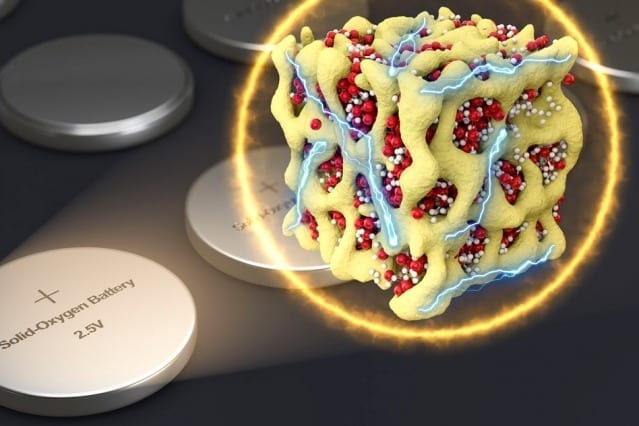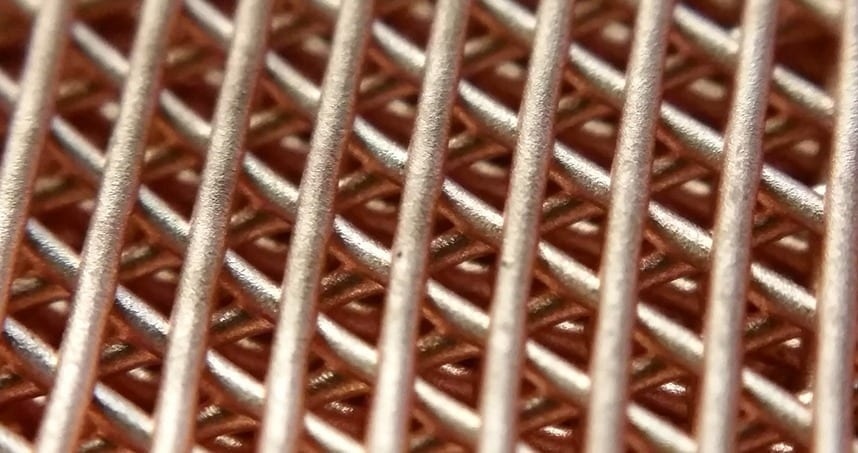
Researchers at the U.S. Department of Energy’s (DOE’s) Argonne National Laboratory have added a twist to lithium-oxygen batteries (Li–O2) by successfully demonstrating for the first time the ability to stabilize crystalline lithium-superoxide (LiO2) which could usher in an entirely new class of batteries.
In research published in the journal Nature, the Argonne researchers were able to produce the stable lithium-superoxide by using a graphene-based cathode. This approach avoids the presence of lithium peroxide (Li2O2), a solid precipitate that clogs the pores of the electrode in lithium-oxygen (aka lithium-air) batteries.
Lithium-air batteries use the oxidation of lithium at the anode of the battery and the reduction of oxygen at the cathode to create a current. This battery design has promised up to 10 times as much energy as a lithium-ion battery at the same weight, giving them an energy density equal to that of gasoline.
While other researchers, like those at the University of Cambridge, have successfully used graphene-based cathodes to avoid the production of lithium peroxide particles, the Argonne team’s work stands apart thanks to a new template growth mechanism for the crystalline lithium-superoxide based on the use of iridium nanoparticles.
Both Larry Curtiss and Khalil Amine, two of the Argonne researchers, credited the growth of the lithium superoxide to the spacing of the iridium atoms in the electrode and believe that iridium will serve as a useful template for the growth of the superoxide going into the future.
The key advantage of a battery based on superoxide, according to the two researchers, is that it enables what is known as a “closed system,” which stands in contrast to open systems that require a constant intake of oxygen from the environment. This makes closed system batteries far safer and more efficient.
“This discovery really opens a pathway for the potential development of a new kind of battery,” said Curtiss, one of the researchers, in a press release. “Although a lot more research is needed, the cycle life of the battery is what we were looking for.”
Amine, added: “The stabilization of the superoxide phase could lead to developing a new closed battery system based on lithium superoxide, which has the potential of offering truly five times the energy density of lithium ion.”
Read more: Stable Superoxide Could Usher in New Class of Lithium-Air Batteries
The Latest on: Lithium-Air Batteries
[google_news title=”” keyword=”Lithium-Air Batteries” num_posts=”10″ blurb_length=”0″ show_thumb=”left”]
via Google News
The Latest on: Lithium-Air Batteries
- Batteries Newson May 5, 2024 at 5:00 pm
May 2, 2024 — Charge-recharge cycling of lithium-superrich iron oxide, a cost-effective and high-capacity cathode for new-generation lithium-ion batteries, can be greatly improved by doping with ...
- Lithium-Air Batteries Market To Reach USD 27.7 Billion By 2032 | DataHorizzon Researchon May 2, 2024 at 1:30 am
The lithium air batteries market size valued at USD 11.4 Billion in 2023 and is anticipated to reach USD 27.7 Billion by 2032 at a CAGR of 10.4%.Fort Collins, Colorado, May 02, 2024 (GLOBE NEWSWIRE) - ...
- Fluffy carbon electrodes bring lithium-air batteries closer to realityon April 22, 2024 at 10:14 pm
Jun Feng, a defendant in a criminal case, has entered a guilty plea, removing pressure on a New York court to decide quickly whether Apple is required to aid investigators by bypassing his iPhone ...
- A sodium-ion battery that can be charged in just a few seconds has been developedon April 22, 2024 at 5:30 am
Existing sodium-ion batteries are broadly divided into sodium-ion batteries (SIBs) and sodium-ion capacitors (SICs). SIBs have a slow redox reaction rate and a relatively high energy density ...
- Advanced Lithium Batteries And New Battery Chemistries On Track To Transform Electric Vehicle Landscapeon March 28, 2024 at 9:12 pm
While these battery technologies, along with metal-air batteries (aluminum-air and lithium-air) are still in the nascent stage, automakers and battery manufacturers are looking at them as new ...
- Britain should not join the gigafactory stampede: technology is already vaulting far aheadon May 18, 2023 at 10:07 pm
Solid state batteries for electric vehicles will start ... Laboratory has found a way to quadruple energy density with a lithium-air battery using a solid electrolyte based on nanoparticles ...
- Wanted: Entrepreneurs To Adopt National Labs’ Climate Technologieson March 27, 2023 at 5:44 am
Consider grid modernization and energy storage: lithium-ion batteries are prevalent today ... Along those lines, the Argonne National Lab’s lithium-air battery uses a solid — not liquid ...
- How Can 335 Horses Weigh 63 Pounds?on February 9, 2022 at 9:19 pm
Weight-to-power ratio for electric motors is tricky because you might not include the weight of the batteries and other supporting equipment. Still, this seems like a lightweight and small powerhouse.
- Creating a new paradigm of technologyon July 24, 2020 at 12:56 am
SAIT is also expanding its research to include all solid-state batteries with oxide electrolytes, and lithium-air batteries. Increasing the potential of electric vehicles is just one facet of ...
- A case study in development of material scienceon March 20, 2019 at 7:16 am
Their results have led to more than 10 patents. In energy materials, the development of ‘breathable’ lithium-air batteries is a good example of innovation at the MSE Institute of New Energy ...
via Bing News










